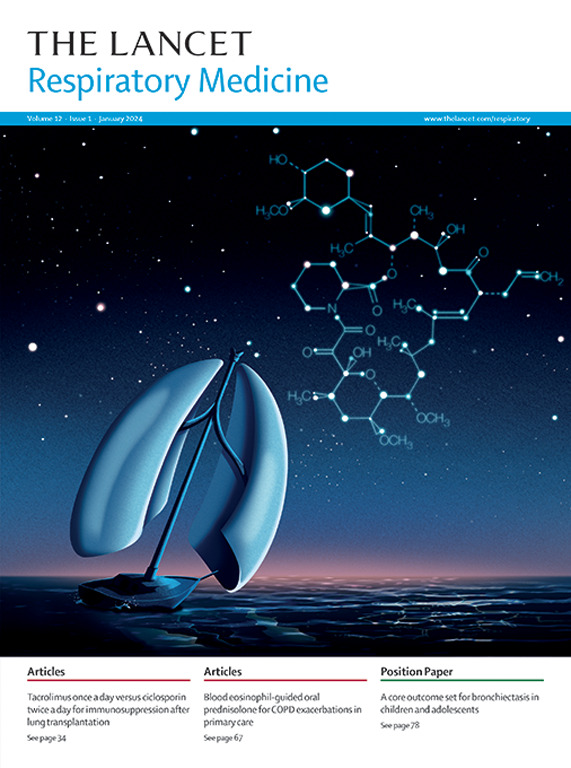Perioperative lung expansion and pulmonary outcomes after open abdominal surgery versus usual care in the USA (PRIME-AIR): a multicentre, randomised, controlled, phase 3 trial
IF 38.7
1区 医学
Q1 CRITICAL CARE MEDICINE
引用次数: 0
Abstract
Background
Postoperative pulmonary complications (PPCs) are a leading cause of morbidity, death, and increased use of health-care resources. We aimed to determine whether a perioperative lung expansion bundle including individualised intraoperative management reduces PPC severity in patients undergoing major open abdominal surgery compared with usual care.Methods
In this multicentre, randomised controlled phase 3 trial (PRIME-AIR), we enrolled adult patients (age ≥18 years) scheduled for an elective open abdominal surgery that would last at least 2 h, who were at intermediate or high risk for PPCs on the basis of their Assess Respiratory Risk in Surgical Patients in Catalonia (ARISCAT) score (a score of ≥26), and who had a BMI below 35 kg/m2 at 17 academic hospitals across ten states in the USA. Participants were randomly assigned (1:1), using permuted block randomisation (a mixture of blocks sizes of 2 and 4; in a 1:2 ratio), stratified by centre, to either usual care or a lung expansion bundle. The bundle comprised preoperative education on PPCs, intraoperative protective ventilation with individualised positive end-expiratory pressure (PEEP) to maximise respiratory system compliance, intraoperative neuromuscular blockade administration and reversal based on patient's weight and neuromuscular transmission monitoring, and postoperative supervised incentive spirometry and mobilisation encouragement. Anaesthesiologists at each site were also randomly assigned to either the intervention bundle group or usual care group, and at each site, at least one unmasked and one masked investigator was designated for each participant. Assessors were masked to treatment assignment. The primary outcome was the highest severity (grade 0–4) of a composite of PPCs by postoperative day 7, including hypoxaemia, respiratory symptoms, atelectasis, bronchospasm, respiratory infection, hypercapnia, pneumonia, pleural effusion, pneumothorax, and ventilatory dependence. The primary endpoint and safety were assessed in the modified intention-to-treat (mITT) population (ie, all participants randomly assigned to treatment who received surgery, and did not withdraw consent or verbal agreement, and excluded those found to be ineligible after randomisation, or for whom consent was not obtained for other reasons). This study is registered with ClinicalTrials.gov, NCT04108130, and is now complete.Findings
Between Jan 24, 2020, and April 5, 2023, we screened 1462 patients, of whom 794 were enrolled and randomly assigned to treatment. The mITT population included 751 participants, of whom 379 (50%) were in the intervention bundle group and 372 (50%) were in the usual care group. Mean age was 61·8 years (SD 12·8); 360 (48%) of 751 patients were female and 391 (52%) were male; 572 (76%) were White, 44 (6%) were Black, 35 (5%) were Asian, and ten (1%) were other races or more than one race. Adherence to bundle components was high (72–98%). Patients in the intervention bundle group received higher mean PEEP (7·5 cmH2O [SD 2·5] vs 5·6 cmH2O [1·4]) and more frequent per-protocol dosing of neuromuscular blockade (334 [88%] of 379 vs 214 [58%] of 372) and reversal (322 [86%] of 375 who received reversal medication vs 250 [70%] of 358) than did those in the usual care group. By postoperative day 7, the most common PPC severity was grade 2 (211 [56%] of 379 in intervention bundle group vs 225 [60%] of 372 in the usual care group). Mean PPC severity was similar in both groups (1·60 [SD 0·94] vs 1·53 [0·93]; mean difference 0·07 [95% CI –0·03 to 0·18]; p=0·19). Occurrence of serious adverse events was similar in both groups. At 7 days postoperatively, one (<1%) patient in the intervention bundle group and two (1%) in the usual care group had died; at 30 days, cumulatively, one (<1%) patient and four (1%) patients had died; and at 90 days, cumulatively, six (2%) patients and five (1%) patients had died, respectively. Adverse events occurred in 71 (19%) of 379 patients in the intervention bundle group and 54 (14%) of 372 in the usual care group, and 35 (9%) patients in each group had serious adverse events.Interpretation
In patients with a BMI of less than 35 kg/m2 who are at moderate-to-high risk of PPCs and undergoing prolonged major open abdominal surgery, a perioperative lung expansion bundle did not reduce PPC severity compared with usual care provided at US academic hospitals.Funding
US National Institutes for Health National Heart, Lung, and Blood Institute.在美国(PRIME-AIR):一项多中心、随机、对照的3期临床试验:围手术期腹部手术与常规护理后肺扩张和肺结局
背景:术后肺部并发症(PPCs)是发病、死亡和增加卫生保健资源使用的主要原因。我们的目的是确定围手术期肺扩张束包括个体化术中管理是否降低PPC严重程度的患者进行大腹部手术与常规护理。方法在这项多中心、随机对照的3期试验(PRIME-AIR)中,我们招募了美国10个州17家学术医院的成人患者(年龄≥18岁),他们计划进行至少2小时的选择性腹部开放手术,根据加泰罗尼亚手术患者呼吸风险评估(ARISCAT)评分(评分≥26),他们处于PPCs的中等或高风险,BMI低于35 kg/m2。参与者被随机分配(1:1),使用排列块随机化(块大小为2和4的混合;以1:2的比例),按中心分层,到常规护理或肺扩张束。该方案包括PPCs术前教育、术中个体化呼气末正压通气(PEEP)以最大限度地提高呼吸系统依从性、术中神经肌肉阻滞给药和基于患者体重和神经肌肉传递监测的逆转、术后监督激励肺活量测定和活动鼓励。每个地点的麻醉师也被随机分配到干预捆绑组或常规护理组,并且在每个地点,为每个参与者指定至少一名未戴面具和一名戴面具的调查员。评估员被蒙面到治疗分配。主要终点是术后第7天PPCs复合的最高严重程度(0-4级),包括低氧血症、呼吸症状、肺不张、支气管痉挛、呼吸道感染、高碳酸血症、肺炎、胸腔积液、气胸和通气依赖。在修改意向治疗(mITT)人群中评估主要终点和安全性(即,所有接受手术且未撤回同意或口头同意的参与者随机分配到治疗组,并排除随机化后发现不符合条件的参与者,或因其他原因未获得同意的参与者)。该研究已在ClinicalTrials.gov注册,编号NCT04108130,现已完成。在2020年1月24日至2023年4月5日期间,我们筛选了1462名患者,其中794名患者入组并随机分配到治疗组。mITT人群包括751名参与者,其中379名(50%)在干预组合组,372名(50%)在常规护理组。平均年龄61.8岁(SD 12.8);751例患者中女性360例(48%),男性391例(52%);572人(76%)是白人,44人(6%)是黑人,35人(5%)是亚洲人,10人(1%)是其他种族或不止一个种族。对束成分的粘附性高(72-98%)。干预组合组患者的平均PEEP更高(7.5 cmH2O [SD 2.5]对5.6 cmH2O[1.4]),并且更频繁地按方案给药神经肌肉阻断(379例中334例[88%]对372例中214例[58%])和逆转(375例中322例[86%]对358例中250例[70%])。到术后第7天,最常见的PPC严重程度为2级(干预组379例中有211例[56%],常规护理组372例中有225例[60%])。两组平均PPC严重程度相似(1.60 [SD 0.94] vs 1.53 [0.93];平均差为0.07 [95% CI为- 0.03 ~ 0.18];p = 0·19)。两组严重不良事件的发生率相似。术后7天,干预组1例(<1%)死亡,常规护理组2例(1%)死亡;30天,累计有1例(1%)患者和4例(1%)患者死亡;在90天,累计有6例(2%)患者和5例(1%)患者死亡。干预组379例患者中有71例(19%)发生不良事件,常规护理组372例患者中有54例(14%)发生不良事件,两组均有35例(9%)发生严重不良事件。解释:对于BMI小于35 kg/m2且有中高PPC风险且接受长时间腹部大开腹手术的患者,与美国学术医院提供的常规护理相比,围手术期肺扩张束并没有降低PPC严重程度。资助美国国立卫生研究院国立心脏、肺和血液研究所。
本文章由计算机程序翻译,如有差异,请以英文原文为准。
求助全文
约1分钟内获得全文
求助全文
来源期刊

Lancet Respiratory Medicine
RESPIRATORY SYSTEM-RESPIRATORY SYSTEM
CiteScore
87.10
自引率
0.70%
发文量
572
期刊介绍:
The Lancet Respiratory Medicine is a renowned journal specializing in respiratory medicine and critical care. Our publication features original research that aims to advocate for change or shed light on clinical practices in the field. Additionally, we provide informative reviews on various topics related to respiratory medicine and critical care, ensuring a comprehensive coverage of the subject.
The journal covers a wide range of topics including but not limited to asthma, acute respiratory distress syndrome (ARDS), chronic obstructive pulmonary disease (COPD), tobacco control, intensive care medicine, lung cancer, cystic fibrosis, pneumonia, sarcoidosis, sepsis, mesothelioma, sleep medicine, thoracic and reconstructive surgery, tuberculosis, palliative medicine, influenza, pulmonary hypertension, pulmonary vascular disease, and respiratory infections. By encompassing such a broad spectrum of subjects, we strive to address the diverse needs and interests of our readership.
 求助内容:
求助内容: 应助结果提醒方式:
应助结果提醒方式:


